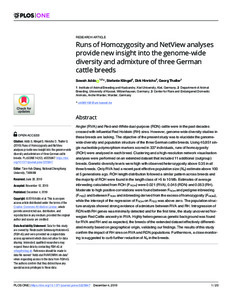Runs of Homozygosity and NetView analyses provide new insight into the genome-wide diversity and admixture of three German cattle breeds
| dc.date.accessioned | 2019-12-13T13:01:19Z | |
| dc.date.available | 2019-12-13T13:01:19Z | |
| dc.date.issued | 2019-12-04 | |
| dc.identifier | doi:10.17170/kobra-20191213868 | |
| dc.identifier.uri | http://hdl.handle.net/123456789/11393 | |
| dc.description.sponsorship | Gefördert durch den Publikationsfonds der Universität Kassel | ger |
| dc.language.iso | eng | eng |
| dc.rights | Urheberrechtlich geschützt | |
| dc.rights.uri | https://rightsstatements.org/page/InC/1.0/ | |
| dc.subject.ddc | 630 | |
| dc.title | Runs of Homozygosity and NetView analyses provide new insight into the genome-wide diversity and admixture of three German cattle breeds | eng |
| dc.type | Aufsatz | |
| dcterms.abstract | Angler (RVA) and Red-and-White dual-purpose (RDN) cattle were in the past decades crossed with influential Red Holstein (RH) sires. However, genome-wide diversity studies in these breeds are lacking. The objective of the present study was to elucidate the genome-wide diversity and population structure of the three German cattle breeds. Using 40,851 single nucleotide polymorphism markers scored in 337 individuals, runs of homozygosity (ROH) were analysed in each breed. Clustering and a high-resolution network visualisation analyses were performed on an extended dataset that included 11 additional (outgroup) breeds. Genetic diversity levels were high with observed heterozygosity above 0.35 in all three breeds. Only RVA had a recent past effective population size (Ne) estimate above 100 at 5 generations ago. ROH length distribution followed a similar pattern across breeds and the majority of ROH were found in the length class of >5 to 10 Mb. Estimates of average inbreeding calculated from ROH (FROH) were 0.021 (RVA), 0.045 (RDN) and 0.053 (RH). Moderate to high positive correlations were found between FROH and pedigree inbreeding (FPED) and between FROH and inbreeding derived from the excess of homozygosity (FHOM), while the intercept of the regression of FROH on FPED was above zero. The population structure analysis showed strong evidence of admixture between RVA and RH. Introgression of RDN with RH genes was minimally detected and for the first time, the study uncovered Norwegian Red Cattle ancestry in RVA. Highly heterogeneous genetic background was found for RVA and RH and as expected, the breeds of the extended dataset effectively differentiated mostly based on geographical origin, validating our findings. The results of this study confirm the impact of RH sires on RVA and RDN populations. Furthermore, a close monitoring is suggested to curb further reduction of Ne in the breeds. | eng |
| dcterms.accessRights | open access | |
| dcterms.creator | Addo, Sowah | |
| dcterms.creator | Klingel, Stefanie | |
| dcterms.creator | Hinrichs, Dirk | |
| dcterms.creator | Thaller, Georg | |
| dc.relation.doi | doi:10.1371/journal.pone.0225847 | |
| dc.type.version | publishedVersion | |
| dcterms.source.identifier | ISSN 1932-6203 | |
| dcterms.source.issue | 12 | |
| dcterms.source.journal | PLoS ONE | |
| dcterms.source.pageinfo | e0225847 | |
| dcterms.source.volume | 14 |
Files in this item
This item appears in the following Collection(s)
-
Artikel [1104]

